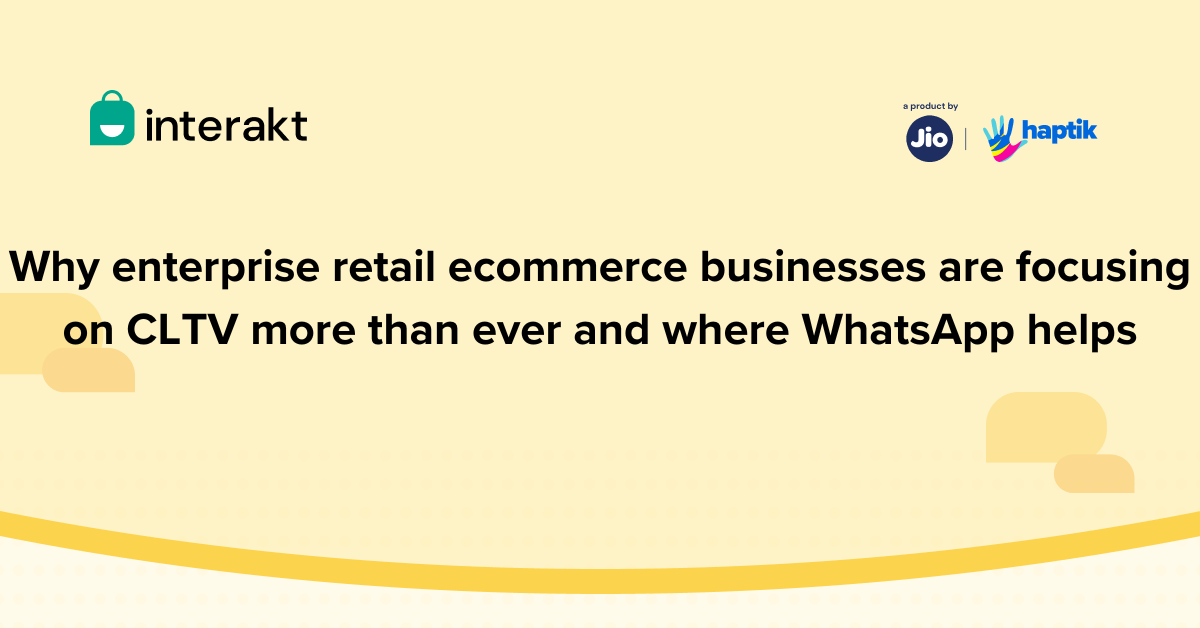
Why enterprise retail ecommerce businesses are focusing on CLTV more than ever and where WhatsApp helps
By 2026, the e-commerce market is expected to total over $8.1 trillion.
And that should not be a surprise. Bygone are the days, when shoppers would go to the local stores looking for products.
Instead, customers prefer to scour products online, which leads to greater competition between eCommerce businesses.
This unfortunate reality puts pressure on marketers and owners to either adapt their customer engagement marketing or lose out to competition who remain ahead of the curve.
But is there a secret formula to:
– Growth in customers
– Increased loyalty and lifetime value
– Increased revenue and business outcomes
Yes – Customer Lifetime Value.
67% of professionals say that their company is not yet measuring CLTV as a core KPI. This is largely because it is a highly-defined KPI, which requires a buy-in & bandwidth from the management & every department. But this secret sauce can be the game changer for the future of eCommerce.
According to Econsultancy’s research, a growing number of companies have now begun to prioritize CLTV. The majority are still at the beginning of the journey, 44% at the developing stage, while 1% at the mature stage.
But why this jump? Let’s find out.
What is CLTV?
Customer Lifetime Value (CLV or CLTV) is the average revenue you can generate from customers over the entire lifetime of their account.
Basically, the money you would make from a customer before churning.
Example – If a customer signs up for your product for twelve months, the amount he will pay during that period will determine his lifetime value.
A good baseline to remember for CLTV is: CLTV > 3x CAC.
Now there are two ways to calculate CLTV:
1. With the accumulated data method, historical sales can be used to calculate the real CLTV of the customer.
CLV = Order 1 + Order 2 +……+ Order n (where n is the number of orders)
2. Average estimate method uses the average order value and the average number of orders based on industry standards.
CLTV = AOV x number of orders
Why is CLTV important?
The heart of a financially viable eCommerce business is the Customer lifetime value. It helps build a clear narrative of the business in the long term; since it is an indicator of product-market fit, brand loyalty and recurring revenue from existing customers.
1. Helps acquire customers
If you know that a customer will spend 500$ over a year as compared to 40$ once; then you can plan a different acquisition strategy with a far more lenient CAC.
By spending more on ads, keywords or influencers, you reach your perfect target audience who will probably turn into loyal customers.
Better product market fit & brand loyalty with the right audience, can give better ROI through higher customer lifetime value.
2. Helps create better products and services
A healthy CLTV points towards brand loyalty, product market fit and a general appreciation for the product. Brand loyalty as a metric is highly appreciated by investors, if you seek funding.
Like, why does an iPhone user keep going back to buy an iPhone. On the contrary, a lower CLTV could indicate the need to pivot to another strategy, improve product quality and benefits.
By mapping the when, where, how much, and how often your customers make purchases, CLTV helps you create more targeted and effective campaigns.
3. Helps predict cash flow for the business
By understanding the consumer pattern of purchase, you can create segments, based on total CLTV. You are able to project and predict the revenue, number of sales and margins.
This can help you manage your business better. Inventory management, vendor payments, salaries and reinvesting in the business are simple problems that can be solved by understanding the cash flow. More so, expansion, R&D, hiring feels more doable with the security of recurring revenue. This helps you truly grow your business.
4. Helps understand the impact on the bottom line
CLTV is the one term that means the most to your bottom line aka profitability. Every single time that you find a new customer, you pay for the cost of acquisition, which leads to reduced margins.
According to Neil Patel, it takes 7X more to acquire new customers than to retain existing customers.
By optimizing for the CLTV, you encourage your existing customers to keep buying from you. That means, no CAC and greater margins. More importantly, you are able to understand which customers and products drive the bulk of your sales. This can help understand customer journeys and churn rates better too.
Now, as with any metric you track in business, knowing the number is not enough. You need to boost your CLTV and here, a direct marketing channel is what becomes crucial.
This is where enterprise retail businesses can be seen exploring WhatsApp.
How can enterprise retail use WhatsApp to boost CLTV?
Around 2 billion users across 180 countries use Whatsapp. These users spend approximately 17 hours per month on WhatsApp.
Can you imagine the scope to connect and convert customers?
Now, let’s see how:
1. Order confirmation and upsell
With automated WhatsApp message send an order confirmation & an upsell message with information about other products/services.
Since you already have an idea about the products they like, these recommendations can be personalized. This can ensure repeat purchases from the same customer, increasing your CLTV.
Pro tip: Add a discount on the next purchase to sweeten the deal.
2. Automate Tracking updates
Keep your customers updated on their orders with automated shipping & delivery updates. From packaging to out for delivery notifications, can make the customer feel more at ease and excited about the upcoming delivery.
3. Abandoned carts
Roughly 70% of your users add items to their carts but leave without checking out & making the payment.
Sending abandoned cart WhatsApp notifications, retargeting messaging or even discounts can help make the sale. Sometimes, all it takes is a simple nudge, to make them a lifetime customer.
4. Implement product education
In the long run, you need to solve for value. Customers might choose other brands, unless you are able to pull them in through tutorials, product education and training. Influencer content, How-to & unboxing videos can be a solid retention strategy for increasing CLTV.
Text, pictures and videos can be sent via WhatsApp which improves accessibility. Some eCommerce websites are now investing in WhatsApp newsletters to create greater value for the customer.
5. Make the buying and return/exchange process easier
According to Forrester’s 2021 Moments Map, 50% of customers surveyed used chat to make purchases. In the younger demographics of 25 to 34-year-olds, the number goes as high as 62%.
If you want, you could even create your storefront on WhatsApp and enable a seamless end-to-end shopping experience.
Making it easy for customers to return/exchange items on WhatsApp can further enhance customer experience. Enable them to simply submit a request with a quick message to your brand on WhatsApp.
6. Improve customer support via WhatsApp
You could place a WhatsApp chat widget on your Ecommerce website. With this button, users can connect with you directly on WhatsApp. This can be a game changer in your customer support since about 39% of customers dislike waiting.
The WhatsApp Business API can help you be available to customers irrespective of time zones.
The best way to leverage this automation, is to let it handle your business’s most common questions: locations, hours, shipping costs, etc. Quick and easy.
An additional feature can be added to transfer queries to a customer support agent for the tougher questions.
It could even collect information from leads or even complete sales through personalized recommendations. If you want, you could even collect product feedback and experience, to understand improvement areas.
7. Promotional messages
From product launches, to new product features or an old product back in stock you coud target 1000s of leads in one go. This ensures brand recall for current customers, and they are more likely to purchase from you.
How can retail brands adapt WhatsApp communication to buyer journeys?
While there are several ways in which brands can stay in touch with their customers on WhatsApp, timeliness is the make or break of engagement – and hence, your CLTV.
This is where brands need to be able to make the most of both proactive customer segmentation and automation to create workflows that are personalized for buyers based on where they are in their journey.
Enterprise retail brands can be seen exploring WhatsApp Business API solutions like Interakt extensively for the same. From being able to run targeted campaigns to managing more conversations, Interakt enables WhatsApp automations that help with improving customer engagement at all stages of the buyer journey.
For example, with Interakt Jio Mart achieved 93% store-to-door success with WhatsApp by handling more than 1500 daily orders on the platform, with a 15% conversion rate. The retail brand also experienced a 68% repeat rate on orders owing to the ease of shopping enabled.
Conclusion
The eCommerce reality is that today’s customer is bombarded with brands and marketing everywhere.
In such tumultuous times, WhatsApp allows you to cut through the noise to keep your customer engaged and loyal, with follow ups & personalized engagement sequences.
With a full stack solution like Interakt, you get a seamless customer experience to grow your business on WhatsApp; thereby improving CLTV.




